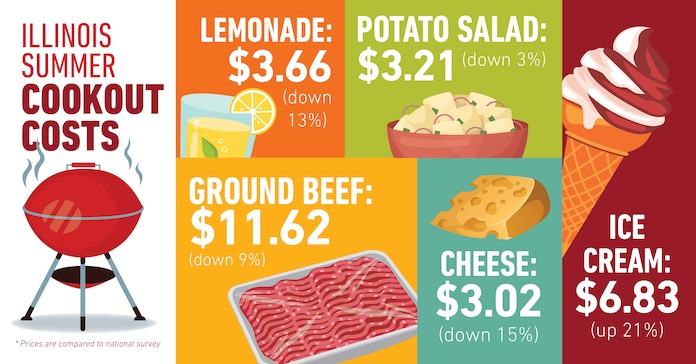Summer cookout costs climb

The cost of a summer cookout continues to climb with inflation and supply chain disruptions driving grocery store prices.
American Farm Bureau Federation’s annual marketbasket survey reported an Independence Day cookout will cost $71.22 for 10 guests this year — a 5 percent jump from last year at $7.12 per person.
The cost rose nearly 30 percent from five years ago and is a record high since AFBF began the survey in 2013.
The cookout favorites include a dozen items, such as cheeseburgers, chicken breasts, pork chops, homemade potato salad, strawberries and ice cream, among other products.
“As families and friends gather to celebrate the Fourth of July, this survey is a reminder that inflation continues to strain all our wallets. Farmers are no exception to this — we often shop at the same grocery stores as our neighbors and friends — but in addition to higher food costs, we are also feeling the pressure of increased production expenses,” Illinois Farm Bureau President Brian Duncan said. “The price of fuel, fertilizer and other necessary inputs that are used to grow America’s food supply have all gone up in recent years.”
Ground beef and lemons saw the highest price increases, while prices dropped for chicken breasts and potato salad.
The retail price for two pounds of ground beef increased 11 percent to $12.77. Lemonade will cost $4.19, up 12 percent from 2023.
AFBF Economist Bernt Nelson said constricting cattle supplies, drought and citrus greening disease are driving those increases.
“The range on the prices of lemons was astronomical. We saw a three-pound bag of lemons as high as $19 in some instances, and so that really pulled up the price of making two and a half quarts of lemonade,” Nelson told RFD Radio.
The survey found two exceptions to the price increases.
Chicken is down 4 percent from last year at $7.83 for two pounds. Potato salad is also 4 percent less expensive than last year, at $3.32. Chicken supplies have stabilized, and potato crops have recovered from the previous year’s poor weather.
Illinois’ cookout cost is 37 cents higher than the national average at $71.59.
Compared with the U.S., the average price of chips in Illinois was 26 percent higher at $6.17, but ground beef and lemons were lower by 9 percent and 12 percent, respectively.
“Inflation really is the biggest underlying factor to most of these price increases, and that really has caused a lot of stress to the consumer, and it’s leading them to have to make difficult decisions when they’re at the grocery store,” Nelson said. “It’s something we haven’t thought of in a while, because we haven’t had real high inflation for quite some time. But when we’re at the grocery store and consumers are evaluating this, they’re having to decide what foods to select to fit their budget, and when things become more costly, these decisions become more critical for a lot of people.”
The U.S. still has one of the most affordable food supplies in the world, with America’s families spending a smaller percentage of their income on food than any other country.
“It is also important to remember that higher grocery store prices don’t necessarily mean that farmers are benefiting. We are price takers, not price makers,” Duncan said. “Yet, despite these challenges, America still has one of the most affordable food supplies in the world thanks to the many programs included in the Farm Bill. That’s why it is crucial for Congress to work together to pass a new, modernized farm bill.”
This story was distributed through a cooperative project between the Illinois Farm Bureau and Illinois Press Association. For more food and farming news, visit FarmWeekNow.com.






